|
Northern
Eclipse Help Reference |
Older Driver Migration |
Installing over an existing installation
Northern Eclipse Version 6.0 or later may not have older digital camera or frame grabber setup routines on the distributed CD. If you have an old working version of Northern Eclipse and driver it may be possible to migrate the older driver to work with Northern Eclipse Version 6.0. To do this install Version 6.0 overtop of the older version (DO NOT UNINSTALL THE OLD VERSION) in the following way:
Installing Northern Eclipse
1/ Insert your Northern Eclipse CD. On most computers it will auto load, but if it does not, double click on the file entitled ECDGUIDE.EXE in the root directory of the CD.
2/ Click on the first Icon “Install Northern Eclipse 6.0”. Once Northern Eclipse begins to install, click on “Next” then, at the Setup Type window, leave the bullet choice at Typical and click “Next”. At this point all of the files will be loaded into c:\eclipse. Click on Finish to complete the installation. Northern Eclipse is now ready to run, but it will only run as offline software (i.e. without camera control). Offline use installation is finished except for some possible personal configurations within Northern Eclipse.
3/ Install the software protection key. A software protection key or
software protection card is included with each new purchase, and is required
for Northern Eclipse to run. The key comes in one of three forms: an ISA card,
a parallel port key or a USB key.
Your computer should be able to accommodate at least one of these and if
we supply the computer we provide you with the appropriate key. The ISA card must be installed in an
8-bit ISA computer slot. We suggest installing the software protection card in
a slot that does not have access to the back plane of the computer case in
order to leave more slots available for other uses (i.e. A hidden slot if
available, or the ISA slot beside the middle PCI slot!). At the present time,
most new computers do not have ISA slots so unless otherwise requested we will
ship the software protection parallel port keys or USB keys. The parallel port
software protection key plugs into a printer port on your computer. A printer
can then be attached to the key, and it should not interfere with
printing. The USB key attaches to
any available USB port on your computer.
Once the key is connected you may need to also install a key driver. If you are running Windows NT/2000/XP you will get the Hardware Protection Key not Found message and Northern Eclipse will not run until you also install the key driver. Windows 95/98/Me does not require a driver to be loaded.
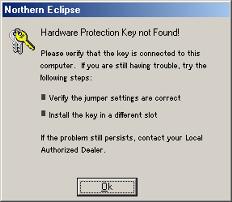
The driver is located on the installation CD and can be installed by selecting “Install Hardlock Driver for NT/2000/XP”
4/ Now it is time to connect to the older camera driver.( If you are not sure which type of camera you have, contact your local supplier or Empix Imaging Inc.) Click Acquire, Camera Options, and then Configure. The following menu will then appear.
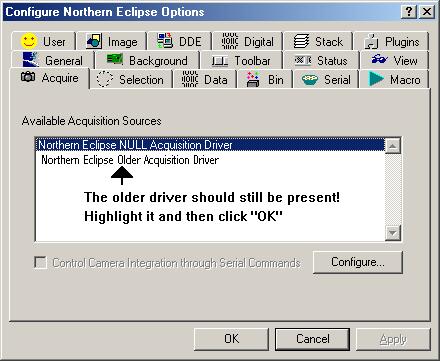
Highlight the older driver and then click “OK”. Your camera should now run as it did before with an older version of Northern Eclipse.
Examples of Version 5.0 driver installations.
1/ DVC Epix Pixi-D Setup
First, with the computer turned off, install the Epix communications card in a PCI slot. This is the card that generally comes with the DVC1310 and DVC1310C cameras. (Note: at the time of writing this setup routine, be sure the 1310 eprom has been installed on the board, and not the 1310C or 1310CP.) Windows 98 is plug and play, so after the digital I/O card has been installed, the next time Windows 98 runs, new hardware will be found and there will be a driver request. The driver can be found on the Northern Eclipse CD, in the drivers section (D:\Drivers\Epix\pixci_d 1.5\Win9x) so please direct Windows to this sub-directory, and then install the driver.
After re-booting load Northern Eclipse from the same installation CD. This is done by clicking on D:\Setup. During the installation pick custom. After picking custom and then clicking next, a select components screen comes up. It is best at this point to de-select frame-grabber and camera drivers that are not necessary. With the DVC Epix Pixi-D card and Northern Eclipse, the following files should either be selected or de-selected. Click on each file to remove the appropriate check marks. If the wrong file is removed, click on it to select it again and the check mark will re-appear.
Northern Eclipse 5.0 Files Select
√Application Files Yes
√Sample Files Yes
Meteor Driver Files No
Princeton Driver Files No
√Offline Driver Files Yes
√OLE Sample Files Yes
Flashpoint 128 Driver Files No
Spot Family Driver Files No
SensiCam Driver Files No
Photometrics Files No
Mutech MV1500 Driver Files No (note, this card also supports DVC)
√EPIX PIXCI-D Driver Files Yes
Once the appropriate files are selected, click on next and let the installation take place. After all the files are installed, the installation program should prompt for a re-boot of the computer. If it does not, shut down and then re-start the computer in the normal fashion. Next launch Northern Eclipse. At this point Northern Eclipse will be using the VGA, only driver. The next step is to pick and configure the Northern Eclipse EPIX PIXCI-D Driver. Click on Acquire along the top of Northern Eclipse menu items, and then click on Camera Options. Highlight Northern Eclipse EPIX PIXCI-D Driver, and then click on Configure. The following menu will then appear.
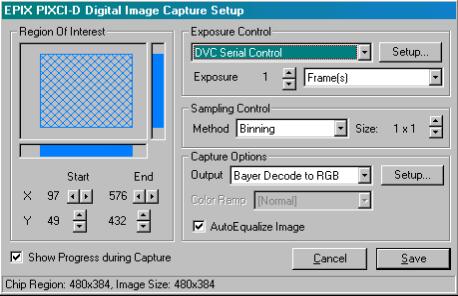
The menu shown is generally the most common setup for a DVC1310C. (Color CCD)
Exposure Control
Most often, Exposure Control for the DVC camera is by way of serial communication, so DVC Serial Control is the standard setup. (With proper cable set the DVC1300 or DVC1300C can be controlled by parallel port communications.) The default serial communications setup for the DVC camera is Port com2, Speed 9600, Parity None, Data Bits 8, Stop Bits 1, Handshaking None. Only the Port would every have to be changed, and this can be done by clicking on Setup, and then changing the Port setting to com1. DVC camera exposures can be changed by adjusting frame times. Each frame time from the DVC camera is 1/12 of a second. Note, this camera should be left in the Frame(s) setting.
Sampling Control
By means of Northern Eclipse, it is possible to sample images during capture from the DVC camera by either Binning or Reduction. Binning is used to increase camera sensitivity by the accumulation data from groups of pixels. The 1x1 binning is the normal full image acquisition. By setting binning to 2x2, sensitivity would increase by 75% and the image size would be reduced in size by 75% (i.e. a 1280x1024 image would be reduced in size to 640x512). Reduction is a pixel reduction method that does not increase sensitivity but increases image frame throughput by reducing the actual image size just as binning does. In both cases, image frame throughput (or frames captured per second) is increased as the binning or reduction setting is increased.
Capture Options
For the DVC1310C (Color CCD), Output should be set to Bayer Decode to RGB, and for the DVC1310 (Mono), Output should set to either [No Conversion] or Convert to 8 Bit. With the DVC1310 no further Setup is required. With the DVC1310C (Color CCD), camera Setup should be clicked, and the following default menu settings will appear:
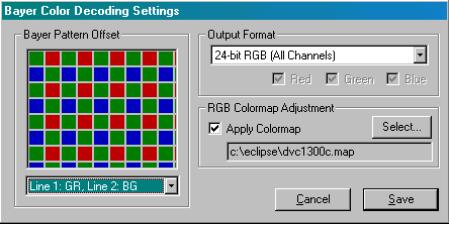
Bayer Pattern Offset
Depending on the version of the EPIX card, the Bayer Pattern Offset will have to set accordingly. Generally older cards use the top choice (Line1: GR, Line 2: BG) and on more recent cards or cards produced after January 2000, use the bottom setting or (Line1: RG, Line 2: GB). If the wrong pattern is chosen, the result will be incorrect color decoding and thus colors will be displayed incorrectly while running the camera, but the fix is easy by picking the alternate pattern.
Output Format
The default format is 24-bit RGB (All Channels). This format forces the camera to capture true 24 bit color images with each color channel being 8 bits deep. Other options are as follows:
48-bit RGB (All
Channels) -produces 48 bit color images with each channel 16 bits deep.
48-bit RGB (Partial) -produces
48 bit color images with each definable channel 16 bits deep.
24-bit RGB (All
Channels) -produces 24 bit color images with each channel 8 bits deep.
24-bit RGB (Partial) -produces
24 bit color images with each definable channel 8 bits deep.
16-bit Monochrome -produces
16 bit images of a defined color channel monochrome source.
8-bit Monochrome -produces
8 bit images of a defined color channel monochrome source.
RGB Colormap Adjustment
The Apply Colormap checkbox is used to apply a color map to incoming images that are either captured through Snap, Auto Expose, Loop, or Digital Focus. DVC cameras as well as many other cameras (i.e. PCO, Hamamatsu, Optronics) use the Sony interline transfer chip. This chip is more sensitive in the green and less sensitive in the red and blue areas of the visible light spectrum. (This chip is also very sensitive in the IR, but generally the camera is shipped with an IR reduction filter.) To balance colors Northern Eclipse allows a custom color map (look up table or LUT) to be used for color balance during acquisition The default color map is the dvc1300c.map, but this can be changed to any color map supplied with Northern Eclipse (files *.map in the c:\eclipse subdirectory) or maps made using the Colormap Editor from within Northern Eclipse. Note that the color map chosen here is changed on the fly when color balance is done while using Digital Focus from within Northern Eclipse, so it is advisable to either use the default dvc1300.map or a new one made with the Colormap Editor.
The AutoEqualize Image checkbox, when checked, will auto balance images during capture. This setting should be left unchecked unless lighting conditions are very weak. Increasing Gain, Exposure and, as a last resort, Offset while using Digital Focus, or Loop should produce better results.
Region Of Interest
It is possible with the DVC camera using Northern Eclipse to select a partial region of the chip. This can be done in a number of ways. Using the mouse place the cursor in the blue hatched region of interest window and then holding down the mouse button drag from the upper left corner down toward the lower right corner. The region can also be changed by changing the Start or End spinner controls. This region can also be changed by way of a macro, Windows script, or OLE application.
Progress Bar
The Show Progress during Capture checkbox when checked will show a progress bar while capturing images. This feature is useful for long exposures, but generally left unchecked for normal use.
2/ PCO Driver Setup
First, with the computer turned off, install the PCO communications card in a PCI slot. This is the card that comes with the PCO camera. Windows 98 is plug and play, so after this digital I/O card has been installed, the next time Windows 98 runs, new hardware will be found and there will be a driver request. The driver can be found on the Northern Eclipse CD, in the drivers section (D:\Drivers\PCO\Sensicam\Win9X 4.05) so please direct Windows to this sub-directory, and then install the driver. After re-booting load Northern Eclipse from the same installation CD. This is done by clicking on D:\Setup. During the installation pick custom. After picking custom and then clicking next, a select components screen comes up. It is best at this point to de-select frame-grabber and camera drivers that are not necessary. With the PCO card and Northern Eclipse the following files should either be selected or de-selected. Click on each file to remove the appropriate check marks. If the wrong file is removed, click on it again to select it again and the check mark will re-appear.
Northern Eclipse 5.0 Files Select
√Application Files Yes
√Sample Files Yes
Meteor Driver Files No
Princeton Driver Files No
√Offline Driver Files Yes
√OLE Sample Files Yes
Flashpoint 128 Driver Files No
Spot Family Driver Files No
√SensiCam Driver Files No
Photometrics Files No
Mutech MV1500 Driver Files Yes
EPIX PIXCI-D Driver Files No
Once the appropriate files are selected, click on next and let the installation take place. After all the files are installed, the installation program should prompt for a re-boot of the computer. If it does not, shut down and then re-start the computer in the normal fashion. Next launch Northern Eclipse. At this point Northern Eclipse will be using the VGA, only driver. The next step is to pick and configure the Northern Eclipse PCO SensiCam Driver. Click on Acquire along the top of Northern Eclipse menu items, and then click on Camera Options. Highlight Northern Eclipse PCO SensiCam Driver, and then click on Configure. The following menu will then appear.
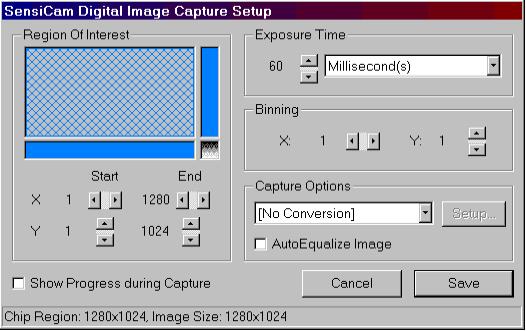
Exposure Control
Exposure can be set to Milliseconds, 1/100th seconds, 1/10th seconds, seconds or minutes.
Sampling Control
By means of Northern Eclipse, it is possible to sample images during capture from the PCO camera by either Binning or Reduction. Binning is used to increase camera sensitivity by the accumulation data from groups of pixels. The 1x1 binning is the normal full image acquisition. By setting binning to 2x2, sensitivity would increase by 75% and the image size would be reduced in size by 75% (i.e. a 1280x1024 image would be reduced in size to 640x512). Reduction is a pixel reduction method that does not increase sensitivity but increases image frame throughput by reducing the actual image size just as binning does. In both cases, image frame throughput (or frames captured per second) is increased as the binning or reduction setting is increased.
Capture Options
For the Color CCD detector chips, Output should be set to Bayer Decode to RGB, and for the Monochrome detector chips, Output should set to either [No Conversion] or Convert to 8 Bit. With the monochrome cameras, no further Setup is required. With the Color CCD cameras Setup should be clicked, and the following default menu settings will appear:

Bayer Pattern Offset
The Bayer Pattern Offset will have to set accordingly. Generally the top choice (Line1: GR, Line 2: BG) is used with the Sony interline transfer chip. If the wrong pattern is chosen, the result will be incorrect color decoding and thus colors will be displayed incorrectly while running the camera, but the fix is easy by picking an alternate pattern.
Output Format
The default format is 24-bit RGB (All Channels). This format forces the camera to capture true 24 bit color images with each color channel being 8 bits deep. Other options are as follows:
48-bit RGB (All
Channels) -produces 48 bit color images with each channel 16 bits deep.
48-bit RGB (Partial) -produces
48 bit color images with each definable channel 16 bits deep.
24-bit RGB (All
Channels) -produces 24 bit color images with each channel 8 bits deep.
24-bit RGB (Partial) -produces
24 bit color images with each definable channel 8 bits deep.
16-bit Monochrome -produces
16 bit images of a defined color channel monochrome source.
8-bit Monochrome -produces
8 bit images of a defined color channel monochrome source.
RGB Colormap Adjustment
The Apply Colormap checkbox is used to apply a color map to incoming images that are either captured through Snap, Auto Expose, Loop, or Digital Focus. PCO cameras as well as many other cameras (i.e. PCO, Hamamatsu, Optronics), use the Sony interline transfer chip. This chip is more sensitive in the green and less sensitive in the red and blue areas of the visible light spectrum. (This chip is also very sensitive in the IR, but generally the camera is shipped with an IR reduction filter.) To balance colors Northern Eclipse allows a custom color map (look up table or LUT) to be used for color balance during acquisition. The default color map is the PCO.map, but this can be changed to any color map supplied with Northern Eclipse (files *.map in the c:\eclipse subdirectory) or maps made using the Colormap Editor from within Northern Eclipse. Note, that the color map chosen here is changed on the fly when color balance is done while using Digital Focus from within Northern Eclipse so it is advisable to either use the default pco.map or a new one made with the Colormap Editor.
The AutoEqualize Image checkbox, when checked, will auto balance images during capture. This setting should be left unchecked unless lighting conditions are very weak. Increasing Gain, Exposure and, as a last resort, Offset while using Digital Focus, or Loop should produce better results.
Region Of Interest
It is possible with the PCO camera using Northern Eclipse to select a partial region of the chip. This can be done in a number of ways. Using the mouse, place the cursor in the blue hatched region of interest window and then holding down the mouse button drag from the upper left corner down toward the lower right corner. Changing the Start or End spinner controls can also change the region. This region can also be changed by way of a macro, Windows script, or OLE application.
Progress Bar
The Show Progress during Capture checkbox when checked will show a progress bar while capturing images. This feature is useful for long exposures, but generally left unchecked for normal use.
3/ Diagnostic Driver
Setup
The Diagnostic Spot family of cameras do not generally follow the standard windows setup, so first use the instruction supplied by Diagnostic Instruments to install the digital I/O card supplied by them with their cameras. Generally they require their software to be installed first, and then the Diagnostics communications card is installed in a PCI slot. Once the Diagnostic card has been installed, and it is possible to capture images with the software supplied by Diagnostics, then install Northern Eclipse from the Northern Eclipse installation CD. This is done by clicking on D:\Setup. During the installation pick custom. After picking custom and then clicking next, a select components screen comes up. It is best at this point to de-select frame-grabber and camera drivers that are not necessary. With the SPOT card, and Northern Eclipse the following files should either be selected or de-selected. Click on each file to remove the appropriate check marks. If the wrong file is removed, click on it to select it again and the check mark will re-appear.
Northern Eclipse 5.0 Files Select
√Application Files Yes
√Sample Files Yes
Meteor Driver Files No
Princeton Driver Files No
√Offline Driver Files Yes
√OLE Sample Files Yes
Flashpoint 128 Driver Files No
√ Spot Family Driver Files No
SensiCam Driver Files No
Photometrics Files No
Mutech MV1500 Driver Files Yes
EPIX PIXCI-D Driver Files No
Once the appropriate files are selected, click on next and let the installation take place. After all the files are installed, the installation program should prompt for a re-boot of the computer. If it does not, shut down and then re-start the computer in the normal fashion. Next launch Northern Eclipse. At this point Northern Eclipse will be using the VGA, only driver. The next step is to pick and configure the Northern Eclipse SPOT Family Driver. Click on Acquire along the top of Northern Eclipse menu items, and then click on Camera Options. Highlight Northern Eclipse SPOT Family Driver, and then click on Configure. The following menu will then appear.
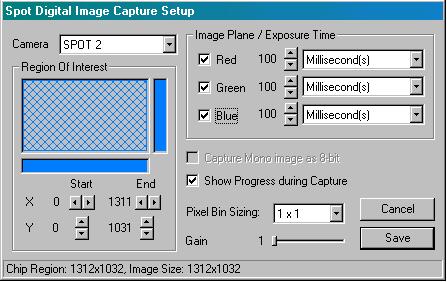
Camera
There are a number of Spot camera models made by Diagnostic
Instruments, and the camera option allows the correct camera to be chosen
(Spot, Spot 2, Spot RT, Spot RT Slider Spot Jr. Etc.).
Image Plane/Exposure
Time
Exposure for each color plane can be set to Milliseconds, 1/100th seconds, 1/10th seconds, seconds or minutes. It is also possible using any of the Red checkbox, Green checkbox or Blue checkbox to include or exclude given color planes from Spot Cameras.
Pixel Bin Sizing
By means of Northern Eclipse, it is possible to sample images during capture from the SPOT camera by either Binning or Reduction. Binning is used to increase camera sensitivity by the accumulation data from groups of pixels. The 1x1 binning is the normal full image acquisition. By setting binning to 2x2, sensitivity would increase by 75% and the image size would be reduced in size by 75% (i.e. a 1280x1024 image would be reduced in size to 640x512). Reduction is a pixel reduction method that does not increase sensitivity but increases image frame throughput by reducing the actual image size just as binning does. In both cases, image frame throughput (or frames captured per second) is increased as the binning or reduction setting is increased.
Gain
By increasing Gain on Spot cameras, exposure can be shortened at the expense of adding slightly more noise. The default Gain setting is 1.
Region Of Interest
It is possible with the SPOT camera using Northern Eclipse to select a partial region of the chip. This can be done in a number of ways. Using the mouse place the cursor in the blue hatched region of interest window and then holding down the mouse button drag from the upper left corner down toward the lower right corner. Changing the Start or End spinner controls changes the region. This region can also be changed by way of a macro, Windows script, or OLE application.
Progress Bar
The Show Progress during Capture checkbox when checked will show a progress bar while capturing images. This feature is useful for long exposures, but generally left unchecked for normal use.
|
See Also |
|
|
References |
Table of Contents |